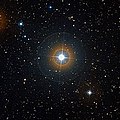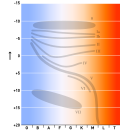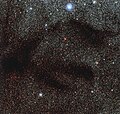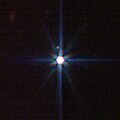A pre-main-sequence star (also known as a PMS star and PMS object) is a star in the stage when it has not yet reached the main sequence. Earlier in its...
4 KB (481 words) - 02:20, 30 August 2024
In astronomy, the main sequence is a classification of stars which appear on plots of stellar color versus brightness as a continuous and distinctive...
62 KB (6,924 words) - 18:53, 25 June 2025
G-type main-sequence star (yellow dwarf or G dwarf) is a main-sequence star of spectral type G. The spectral luminosity class is typically V. Such a star has...
12 KB (1,164 words) - 19:28, 26 June 2025
An A-type main-sequence star (A dwarf) is a main-sequence (hydrogen burning) star of spectral type A. The spectral luminosity class is typically V. These...
12 KB (1,070 words) - 19:18, 26 June 2025
A K-type main-sequence star (K-type dwarf or orange dwarf) is a main-sequence (hydrogen-burning) star of spectral type K. The luminosity class is typically...
13 KB (1,422 words) - 19:30, 26 June 2025
An F-type main-sequence star is a main-sequence, hydrogen-fusing star of spectral type F. Such stars will generally have a luminosity class of V. They...
11 KB (1,229 words) - 18:39, 26 June 2025
Hypergiants absolute magni- tude (MV) A B-type main-sequence star is a main-sequence (hydrogen-burning) star of spectral type B. The spectral luminosity...
12 KB (1,356 words) - 19:39, 26 June 2025
in the pre-main-sequence phase of stellar evolution. It ends when a star of 0.5 M☉ or larger develops a radiative zone, or when a smaller star commences...
8 KB (901 words) - 02:38, 21 March 2025
Hypergiants absolute magni- tude (MV) An O-type main-sequence star is a main-sequence—core hydrogen-burning—star of spectral type O. The spectral luminosity...
12 KB (1,342 words) - 19:25, 26 June 2025
showed that the pre-main-sequence star can remain in radiative equilibrium throughout some period of its contraction to the main sequence. The Henyey track...
5 KB (601 words) - 23:30, 15 March 2025
Red dwarf (redirect from M-type main-sequence star)
red dwarf is the smallest kind of star on the main sequence. Red dwarfs are by far the most common type of fusing star in the Milky Way, at least in the...
48 KB (5,552 words) - 00:37, 20 June 2025
Protostar (redirect from Proto-star)
infalling gas is depleted, leaving a pre-main-sequence star, which contracts to later become a main-sequence star at the onset of hydrogen fusion producing...
10 KB (1,217 words) - 03:26, 24 May 2025
A Herbig Ae/Be star (HAeBe) is a pre-main-sequence star – a young (<10 Myr) star of spectral types A or B. These stars are still embedded in gas-dust...
5 KB (569 words) - 14:55, 14 December 2024
In stellar evolution, an FU Orionis star (also FU Orionis object, or FUor) is a pre–main-sequence star which displays an extreme change in magnitude and...
5 KB (615 words) - 15:19, 19 June 2025
Star formation Object classes Interstellar medium Molecular cloud Bok globule Dark nebula Young stellar object Protostar Pre-main-sequence star T Tauri...
4 KB (392 words) - 00:41, 3 June 2025
Stellar evolution (redirect from Life cycle of a star)
accretion of gas and dust from the molecular cloud, becoming a pre-main-sequence star as it reaches its final mass. Further development is determined...
50 KB (6,439 words) - 09:11, 24 June 2025
monitoring of a pharmaceutical drug or device Pre-main-sequence star, a star that has not yet reached the main sequence Phelan-McDermid Syndrome, a rare genetic...
2 KB (297 words) - 12:10, 26 December 2022
HD 100546 (category B-type main-sequence stars)
a pre-main sequence star of spectral type B8 to A0 located 353 light-years (108 parsecs) from Earth in the southern constellation of Musca. The star is...
34 KB (3,128 words) - 02:10, 20 June 2025
Myr A-class pre-main-sequence star HD 95086. It is roughly 5 times as massive as Jupiter and orbits about 70 AU away from the parent star. It was detected...
12 KB (1,085 words) - 21:54, 27 September 2024
may be a main sequence star with a stellar class of B2. In 2007, a third companion was announced, which may be a low mass, pre-main sequence star. The X-ray...
18 KB (1,556 words) - 22:06, 24 January 2025
K2-33 (category Pre-main-sequence stars)
K2-33 is an extremely young pre-main-sequence star located about 453 light-years (139 pc) away from the Earth in the constellation of Scorpius. It is known...
12 KB (1,315 words) - 03:45, 4 June 2025
fan-shaped nebula opens from the star R Coronae Australis toward the star T CrA to the south-east. R CrA is a pre-main-sequence star in the Corona Australis molecular...
3 KB (193 words) - 18:36, 18 January 2024
TOI-1227 b (section Host star)
first identified as a pre-main-sequence star (PMS star) with the Gaia satellite. Without this prior identification as a PMS star the exoplanet signal of...
9 KB (832 words) - 21:36, 12 June 2025
HD 95086 (redirect from Aiolos (star))
HD 95086, formally named Aiolos, is a pre-main-sequence star about 282 light-years (86 parsecs) away. Its surface temperature is 7,750±250 K. HD 95086...
12 KB (978 words) - 02:26, 20 June 2025
1RXS J160929.1−210524 (category Pre-main-sequence stars)
PZ99 J160930.3−210459) is a pre-main-sequence star approximately 450 light-years away in the constellation of Scorpius. The star was identified as a member...
13 KB (1,319 words) - 13:43, 9 October 2024
EPIC 204278916 (category Pre-main-sequence stars)
EPIC 204278916 is a pre-main-sequence star, about five million years old with a spectral type of M1, implying a red dwarf. It is part of the Upper Scorpius...
6 KB (548 words) - 15:47, 13 March 2025
V1400 Centauri (category Pre-main-sequence stars)
known as 1SWASP J140747.93−394542.6 or simply J1407, is a young, pre-main-sequence star that was eclipsed by the likely free-floating substellar object...
30 KB (2,802 words) - 00:12, 20 March 2025
the end of their main sequence lifetime. Higher density regions of the interstellar medium form clouds, or diffuse nebulae, where star formation takes...
49 KB (5,712 words) - 04:40, 30 June 2025
that occurs when the surface of a star or a planet cools. The cooling causes the internal pressure to drop, and the star or planet shrinks as a result. This...
7 KB (1,185 words) - 13:56, 1 May 2025























